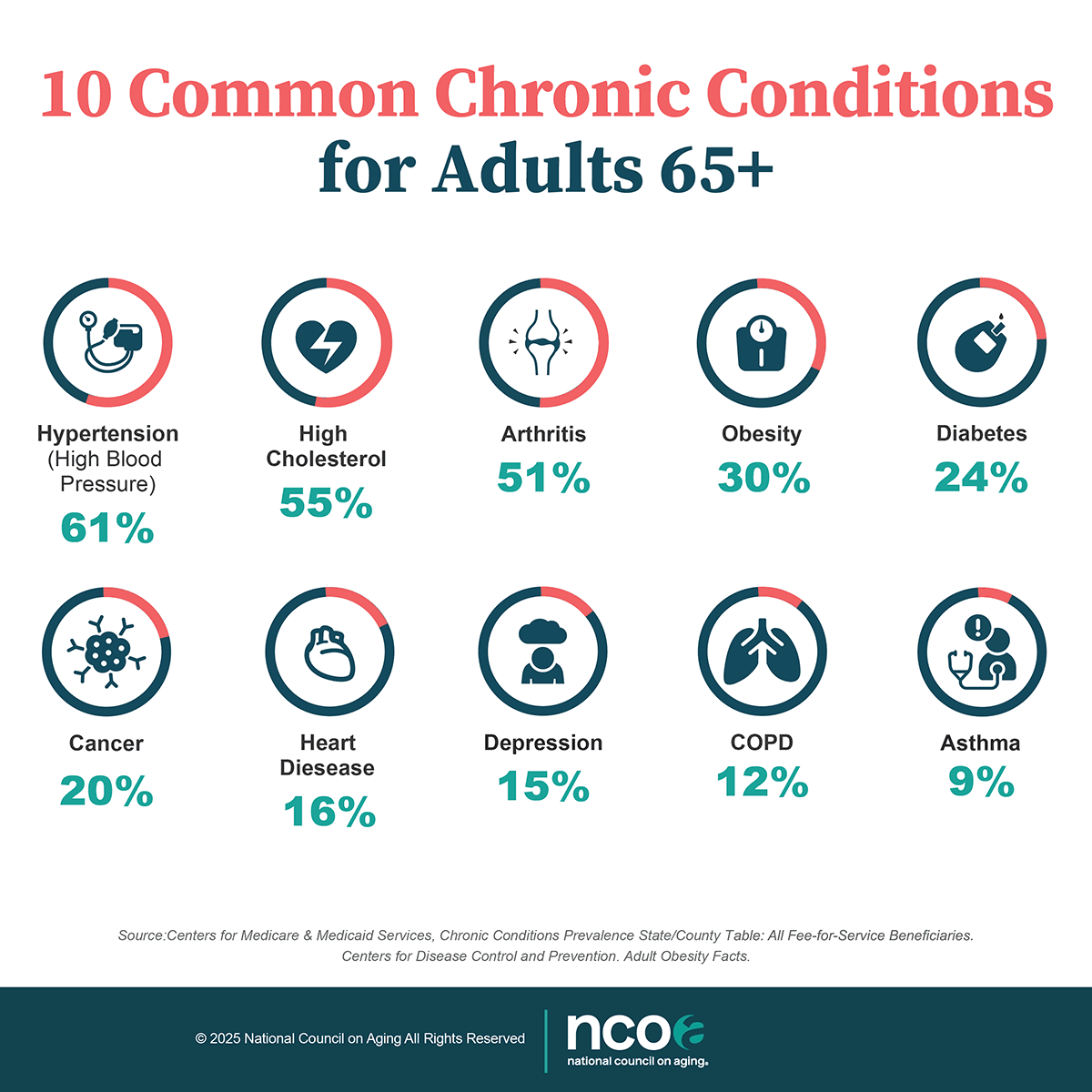
Related Topics
Age, family genetics, and gender make it nearly impossible for older adults to avoid becoming a chronic disease statistic. According to research published in 2025, 93% of adults age 65 and older have at least one condition, while 79% have two or more.1 You probably have a parent or grandparent who is managing a condition right now, or perhaps you are managing one yourself.
And obesity, which impacts about 30% of adults 65 and older,1 can increase your risk for conditions like heart disease, type 2 diabetes, and some cancers.2
With these kinds of odds, you might wonder if there is anything you can do to prevent the onset of a chronic medical condition, or make managing an existing one easier. The answer is yes.
Here to top 10 most common chronic conditions among adults 65+,1 and what you should know about each.

Number 10: Asthma
An estimated 9% of adults 65+ have asthma, which causes swelling and tightening of the airways in the lungs. Common symptoms are shortness of breath, coughing, chest tightness, wheezing, and difficulty exercising.
Among older adults, it's common for asthma to go undiagnosed because the symptoms can be mistaken for other issues such as heart problems or COPD, according to the American Academy of Allergy, Asthma and Immunology.3 Their advice for older adults with asthma includes:
- Quit smoking or vaping
- Get appropriate vaccines
- Avoid known asthma triggers
Number 9: COPD
About 12% of older adults 65+ have chronic obstructive pulmonary disease (COPD), which includes two main conditions: emphysema and chronic bronchitis. COPD makes it hard to breathe and causes shortness of breath, coughing, and chest tightness.
Steps you can take to manage COPD include:
- The best way to prevent COPD—or slow its progression—is to quit or avoid smoking. Also try to avoid secondhand smoke, chemical fumes, and dust, which can irritate your lungs.
- If you already have COPD, complete the treatments that your doctor has prescribed, get the flu and pneumonia vaccines as recommended by your doctor, and continue to remain active.
Number 8: Depression
15% of older adults have depression—a treatable medical condition that is not a normal part of aging. Depression causes persistent feelings of sadness, pessimism, hopelessness, fatigue, difficulty making decisions, changes in appetite, a loss of interest in activities, and more.
Steps you can take to help with depression include:
- Manage stress levels. Reach out to family and friends during rough spells and consider regular meditation.
- Eat a healthy diet. What you put into your body can affect your mood, so focus on foods that are high in nutrients and promote the release of endorphins and those "feel good" chemicals, and limit consumption of things like alcohol, caffeine, artificial sweeteners, and highly processed foods.
- Routine exercise. Exercise has a number of physical and psychological benefits, including improving your mood through the release of endorphins and other "feel good" brain chemicals, boosting self-confidence and self-worth through meeting goals and improving your physical appearance, and increased socialization through interactions at gyms and group classes.
- Talk to your doctor. If you've experienced any of the warning signs of depression, talk to your doctor, and ask about your treatment options. Antidepressant medications or psychotherapy could be right for you.
If you’re in severe emotional distress, one of the first things you should do is tell someone else about it—such as a trusted friend or family member. You can also dial or text 988 from your phone to speak with a counselor who is specially trained in suicide prevention. The 988 service is free, confidential, and available to everyone in the United States 24 hours a day, 7 days a week.
Number 8: Heart disease
About 16% of older have heart disease—a condition that occurs when the heart cannot adequately supply blood and oxygen to all of the organs in the body. The heart might become enlarged, develop more muscle mass, or pump faster in order to meet the body’s needs, causing you to feel tired, light headed, nauseous, confused, or lack an appetite.
Steps you can take to prevent or diminish symptoms of heart disease:
- The best prevention is to follow a doctor's recommendations to decrease your risk for coronary heart disease and high blood pressure.
-
Number 5: Ischemic heart disease (or coronary heart disease)
Nearly 29% of older adults were treated for ischemic heart disease—a condition that is caused by a build-up of plaque that narrows the arteries leading to the heart. Narrow or blocked arteries decreases the amount of oxygen-rich blood delivered to the heart. This can cause other complications like blood clots, angina, or a heart attack.
Steps you can incorporate to help if you have ischemic heart disease:
- Avoid saturated and trans fats, and limit sugar and salt intake
- Get seven to eight hours of sleep each night
- Keep your stress levels in check
- Do regular cardio exercises
- Abstain from smoking
- Talk to your doctor about the major risk factors, including high cholesterol and high blood pressure
Number 6: Cancer
Cancer impacts 20% of older adults.
Routine screenings are important for catching cancer in its earlier, more treatable stages. Your health provider can give you recommendations on what screenings are right for you.
Tips for cancer prevention include:
- Wear sunscreen
- Avoid tobacco
- Limit alcohol
- Maintain a healthy weight
- Get regular exercise
Number 5: Diabetes
Twenty-four percent of older adults have diabetes—a disease that occurs when your body is resistant to, or doesn’t produce enough, insulin. Insulin is what your body uses to get energy from food, and distributes it to your cells. When this doesn’t happen, you get high blood sugar, which can lead to complications such as kidney disease, heart disease, or blindness. Chances of having diabetes increases after age 45.
Steps you can take to keep you from developing diabetes or to manage this condition:
- Eating a healthy diet, including monitoring your carbohydrate and calorie intake, and talking to your doctor about alcohol consumption.
- Exercising for 30 minutes five times a week to keep your blood glucose levels in check, and to control weight gain.
- Safely losing 5-7% of body weight if you are diagnosed with pre-diabetes.
Number 4: Obesity
About 30% of adults 65 and older are living with obesity, a chronic disease linked to more than 200 chronic conditions. NCOA is pressing to define quality obesity care as a universal right. That includes the right to coverage for treatment with access to the full range of treatment options.
Steps you can take to delay the onset of obesity or manage the symptoms:
- Understanding what obesity treatments are covered by Medicare
- Empowering yourself with knowledge about nutrition
- Educating others and being your own advocate
Number 3: Arthritis
About 51% of older adults live with arthritis—an inflammation of your joints, which causes pain and stiffness and is more common in women.
Steps you can take to delay the onset of arthritis or manage the symptoms:
- Exercise at least five times per week, for 30 minutes each time, to improve function and decrease pain. Try to include a mixture of aerobic, strength-building, and stretching movements.
- Stay within the recommended weight for your height—losing one pound can remove four pounds of pressure on your knees.
- Make sure your back, legs, and arms are always supported.
- Take precautions to avoid joint injuries.
- Do not smoke.
Number 2: High cholesterol
Fifty-fiv percent of older adults have high cholesterol—a condition that occurs when your body has an excess of bad fats (or lipids), resulting in your arteries getting clogged, which can lead to heart disease.
Steps you can take to prevent or manage high cholesterol:
- Abstain from smoking and excessive alcohol consumption
- Be active each day
- Manage your weight
- Minimize saturated fats and trans fats in your diet
Number 1: High blood pressure
About 61% of older adults have hypertension—a common condition that involves both how much blood your heart pumps, as well as how resistant your arteries are to the blood flow. When your heart pumps a lot of blood, and you have narrow arteries which resist the flow, that’s when you get high blood pressure, also known as hypertension. The danger of hypertension is not only that you can have it for years and not know it, but it can cause other serious health conditions, like stroke and heart attacks.
Steps you can take to prevent or reduce high blood pressure:
- Maintain a healthy weight. Losing just 10 pounds can reduce blood pressure
- Regulate your stress levels
- Limit salt and alcohol consumption
- Exercise daily, including a combination of moderate to vigorous-intensity aerobic activities, flexibility and stretching, and muscle strengthening
- Check your blood pressure regularly—the quicker you catch pre-hypertension, the more likely you are to prevent high blood pressure
When these tactics aren’t enough to help with your chronic condition
The above tips can help you avoid or successfully manage a chronic condition. However, if you or someone you know is struggling to manage a chronic condition, there are programs in your community that can help, like the Chronic Disease Self-Management Program (CDSMP). CDSMP is a six-week, interactive, small-group workshop that helps participants build the skills necessary to control how chronic conditions affect their life.
CDSMP workshop sessions focus on the following topics:
- Dealing with fatigue, pain, frustration, or isolation
- Maintaining strength, flexibility, and endurance
- Managing medications
- Communicating with family, friends, and health professionals
- Healthy eating
To learn more about workshops in your community and how to live with a chronic illness, contact your local area agency on aging.
Sources
1. Kathleen B. Watson, PhD, et al. Trends in Mulitple Chronic Conditions Among US Adults, By Life Stage, Behavioral Risk Factor Surveillance System, 2013-2023. Preventing Chronic Disease. April 17, 2025. Found on the internet at https://www.cdc.gov/pcd/issues/2025/24_0539.htm
2. Centers for Disease Control and Prevention. Overweight & Obesity. Why it Matters. Found on the internet at https://www.cdc.gov/obesity/about-obesity/why-it-matters.html
3. American Academy of Allergy Asthma and Immunology. Asthma Among Older Adults. Found on the internet at https://www.aaaai.org/tools-for-the-public/conditions-library/asthma/asthma-older-adults




